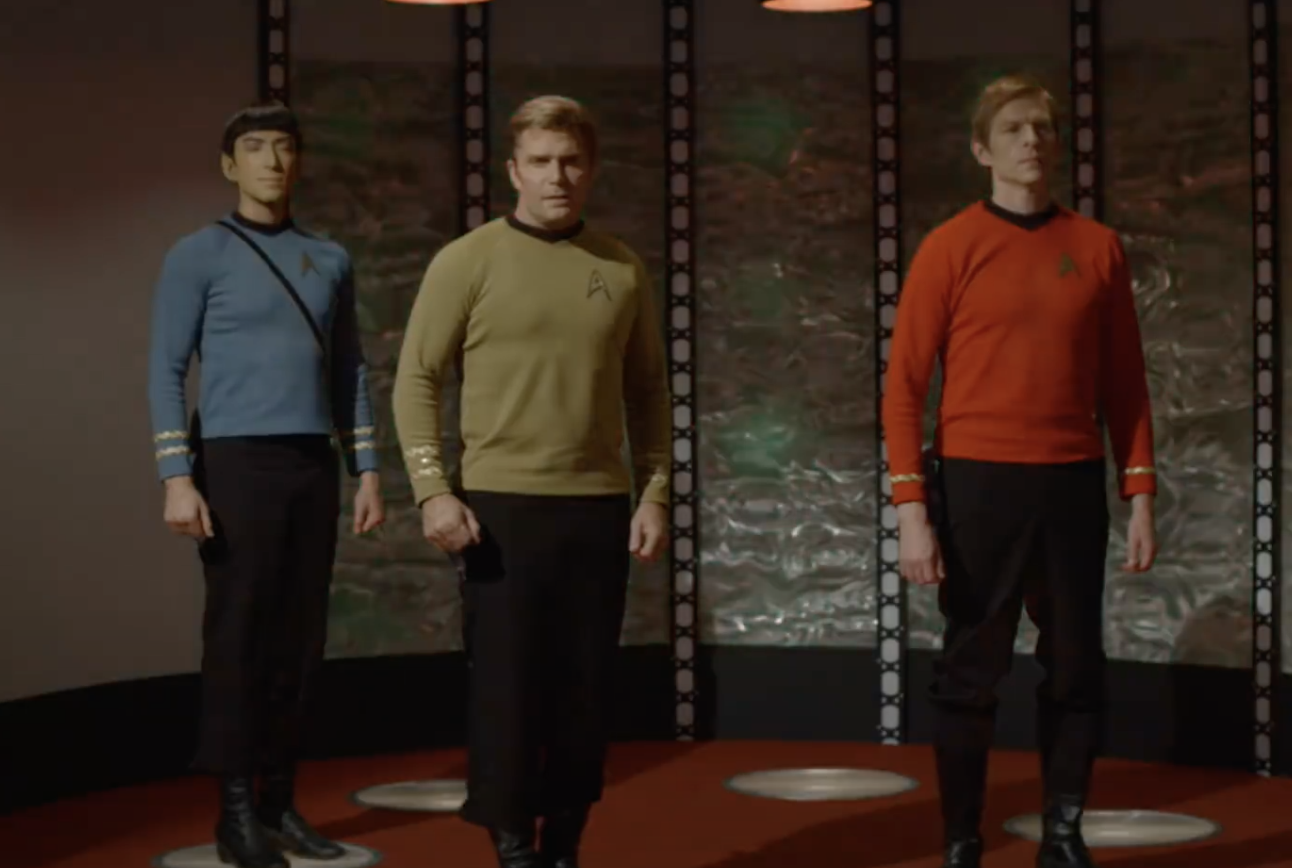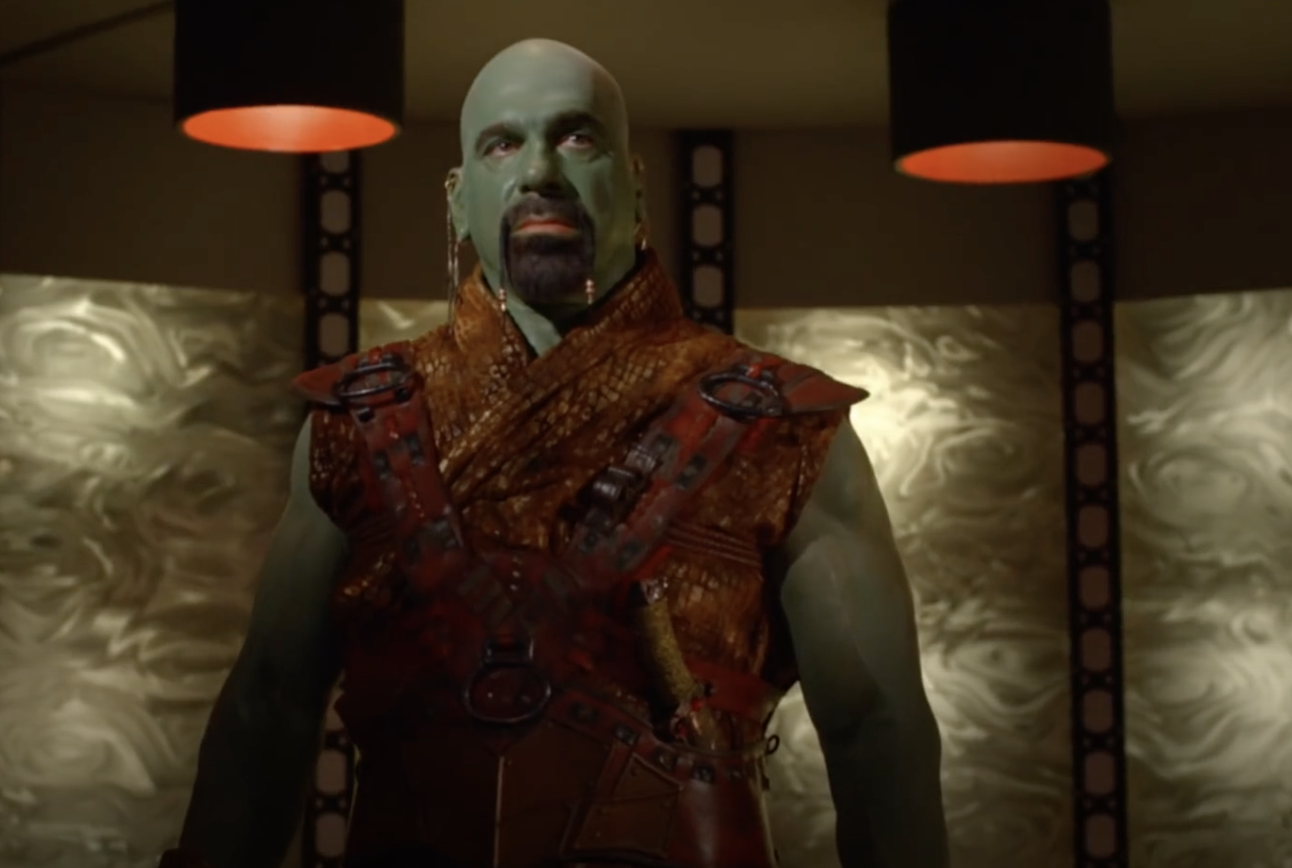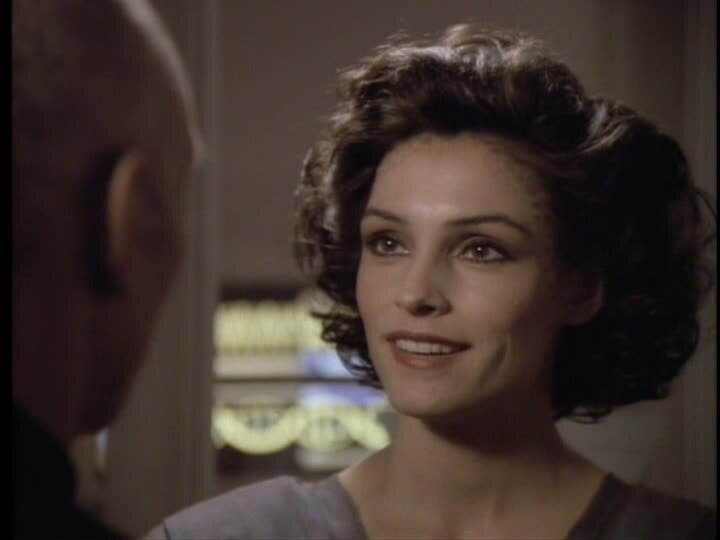There are countless Star Trek fan films available on YouTube, but Star Trek Continues is in a league of its own. In an age of big-budget network spin-offs such as Star Trek: Discovery and Picard, it’s refreshing to find a fan series that so beautifully nails the looks, themes, and fun of the original series. There are no JJ Abrams-style lens flares or coolifying of technology and characters in an attempt to fix a problem that never existed; instead, each episode is a lovingly-crafted homage to the 60s series. Every element, from the sets, props, costumes, lighting, camera angles, special effects, and music, is a faithful reproduction. It quite literally is a continuation of ST:TOS. Perhaps the highest praise came after my wife and I watched “What Ships are For” together, and after the credits rolled, complete with stills of Scotty in a Jeffries Tube and the dancing Orion slave girl, we both stared, stunned, and said, “Wow. That was a real Star Trek episode.”
Even the special effects capture the accurate look of the 60s series models, avoiding the pitfalls of modernizing everything with CGI
Kirk is played by Vic Mignona, who also writes and directs the episodes.
It would be easy for anyone to turn Kirk into a bad Shatner impersonation, but Vic does a brilliant job of playing Kirk and not Shatner. He emulates Shatner’s body language - for example, Shatner’s habit of bowing out his elbows when standing on a transporter platform, balling his fists as if ready for a fight - but delivers dialogue and often soliloquies with a cadence that reminds of you of Kirk without Shatner’s overt pausing of each word for emphasis. Nicely done.
Spock is played by Todd Haberkorn.
Todd’s rendition of Spock is more like Vulcans in later series, such as Tuvok from Voyager, and tends to be matter-of-fact. Nimoy’s Spock tended to infuse emotion into his responses, at times being on the verge of smiling (sometimes nearly out-of-character for Spock), and the 60s series did a good job of giving Nimoy some excellent lines to work with, such as this classic exchange:
I’d like to see more of the original series’s cleverness in Spock’s writing, and more of Nimoy’s “human underneath” emoting in the Spock character, but Star Trek Continues delivers a solid Spock, including episodes where Spock is at odds with duty, friendship, and logic.
In the first two episodes, McCoy is played by Larry Nemecek before the role is picked up by Chuck Huber. Huber is a much better fit for McCoy. I’m not sure what happened in the first episode with the dialogue and casting for McCoy, but he was nearly unrecognizable to me. I wondered for a minute if he was supposed to be the original doctor from the ST:TOS pilot with Captain Pike, which has Chief Medical Officer Phillip Boyce instead of Doctor McCoy. Once the series transitions to Huber, McCoy solidifies. Huber plays McCoy with more warmth than DeForest Kelley, whose crankiness was, let’s face it, grating at times, and Huber’s rendition is welcome.
Chuck Huber as McCoy
Notable support characters include Chris Doohan (James Doohan’s son) as Scotty, who, not surprisingly, has his father’s mannerisms down to an art, and of couse looks like him. Mythbuster’s Grant Imahara plays Sulu. He starts the series trying to impersonate George Takei a bit too much, but comes into his own mid-series. Kim Stinger plays Uhura. She’s a little more like the JJ Abram’s version of Uhura than Nichelle Nichol’s rendition, but she brings a warmth to the character. Wyatt Lenhart plays Checkov, and is a charmer. The series introduces a ship’s counselor, in the vein of Next Generation’s Deanna Troi, with Michele Spect playing Elise McKennah. Spect plays the character with warmth and humor.
Chris Doohan’s Scotty
Kim Stinger’s Uhura
Wyatt Lenhardt’s Chekov
Grant Imahar’s Sulu
Michele Spect’s McKenna
The guest stars for the series are a who’s who of sci-fi. Just check out the series page for a list. A few stand-outs:
Erin Gray (Buck Rogers’s Wilma Deering) as Commodore Gray
Marina Sirtis (ST:TNG’s Deanna Troi) as the voice of the computer
John deLancie (Star Trek’s Q) as an ambassador
Cas Anvar (The Expanse’s Alex) as a Romulan
Jamie Barber (Battlestar Galactica’s Apollo) as a red shirt
Nicole Bryant (Doctor Who’s Pen) as an esper
Michael Forest (ST:TOS’s god Apollo, reprising the role)
Lou Ferrigno (the 70s Hulk) as an Orion Slave Master
PILGRIM OF ETERNITY
1967’s “Who Mourns Adonis” had the Enterprise encounter a powerful entity who claimed to be the god Apollo, played by Robert Forest. The episode ends with the Enterprise phasering his temple, which was his source of power, and having him fade away.
Two years later, in Star Trek Continue’s timeline, the crew encounters him again, now aged rapidly to his 80s. He appears to be powerless, but of course not all is as seems, and soon Apollo is up to his old tricks of seeking mortal adulation and smiting wrath upon those who challenge him. Robert Forest reprises his role as Apollo forty-six years after his original appearance.
LOLANI
In the 60s series, the green-skinned Orion slave girl is memorable for always appearing in the ending credits, yet in reality, she never appeared in an episode with Kirk. Her only appearance was in the unaired pilot with Captain Pike (and later in the Kirk episode which played flashbacks from the pilot at Spock’s trial in “The Menagerie”). In Star Trek Continue’s “Lolani”, the crew rescues a Orion slave from a Tellerite ship. After she spends time getting to know the crew, her slave master shows up demanding his property back, setting up a classic Star Trek conflict of “don’t interfere in other people’s cultures vs. what if what their culture does is morally reprehensible”.
Fiona Vroom as the Orion slave girl.
Lou Ferrigno as the Orion slave master.
You know that Kirk will end up in a fist-fight with the slave master, who, as Lou Ferrigno, towers over him. I literally cheered when Kirk did his patented horizontal double-footed kick to the chest.
The episode reminds me in theme of the Next Generation episode “The Perfect Mate”, in which Picard transports a metamorph woman who is intended to be a gift for a peace treaty. Picard wrestles with judging other’s culture versus allowing a woman to be treated as property.
Famke Jannsen as Kamala in “The Perfect Mate”
THE FAIREST OF THEM ALL
The evil-Spock goatee universe featured in 1967’s “Mirror, Mirror” has been visited by numerous Trek series. In Star Trek Continues, the episode continues in the evil universe seamlessly from where the original ends, with the evil Kirk beaming back to the transporter pad as the good Kirk beams out. In the original episode, good Kirk planted seeds of doubt of evil Spock’s mind, and those seeds flourish in Star Trek Continues “Fairest of the All”. If you listen carefully, Michael Dorn (Worf from ST:TNG) is the computer’s voice on the evil Enterprise.
Asia de Marcos is a dead ringer for the original actress who played Marlena in “Mirror, Mirror”
THE WHITE IRIS
Every Star Trek series has an episode where the Captain is injured and goes through mental soul searching to recover. In “The White Iris”, Kirk is treated with an experimental drug after being critically injured, which causes him to see women from his past who died, nearly all of which were characters in ST:TOS episodes. The episode uses the holodeck, which also appears in the first Star Trek Continues episode, but feels a bit out-of-place considering Star Trek: the Next Generation treated it as new technology in it’s 1987 pilot, “Encounter at Farpoint”.
DIVIDED WE STAND
When the Enterprise encounters an old earth spaceship, Friendship 3, they unknowingly get infected with nanites. As the nanites spread through the ship’s systems, Kirk and McCoy are injured and infected. When they awake, they’ve been transported back to Earth’s civil war as soldiers on opposing sides.
This is a predictably heavy episode, with all of the civil war’s horrors of unanesthesized limb amputations and mistreatment of captured soldiers. Kirk gives some inspiring speeches about freedom and is happy to glimpse President Lincoln, who I recall from 1969’s “The Savage Curtain” is one of Kirk’s favorite presidents. There is an undercurrent of persevering with disabilities.
I had to Google Friendship 3 because it sounded familiar. Friendship 1 was featured in the Voyager episode, “Friendship One”. In it, the crew discovers an old Earth spaceship crashed on a nuclear-winter world. They find the inhabitants weren’t ready for the advanced technology found on the crashed ship, misusing it to destroy themselves.
COME NOT BETWEEN THE DRAGONS
A monster episode - sort of. When a rock-like creature crashes through the Enterprise, the crew becomes increasingly violent as they react to energy pulses that seem to be connected to the creature.
This episode reminded me a bit of the original series “Day of the Dove” where an energy creature fueled animosity between everyone on board, living off their anger.
EMBRACING THE WINDS
Trial episodes are a staple of Star Trek. In “Embracing the Winds”, the U.S.S Hood’s crew and captain are lost after a life-support failure, and Commodore Gray (Buck Roger’s Erin Gray) must assign a new captain. When she offers the position to Spock, another officer petitions on the grounds that Starfleet only assigns male captains to Constitution-class starships, and she is being overlooked as a female. The resulting trial to choose between Spock and Commander Garrett (Clare Kramer) navigates the waters between sexism and affirmative action. This episode could easily have stumbled through a minefield but managed to pull it off with grace. I think I especially like it because the 60s series, despite it’s manly captains and Kirk’s womanizing, was exceptionally diverse, and Star Trek has always been forward-leaning in its societal commentary.
Clare Kramer
At the episode’s end, Commander Garret says, “Who knows? Perhaps someday a Garrett will command the Enterprise?” It’s a nice nod forward to Star Trek: The Next Generation’s “Yesterday’s Enterprise”, where the Enterprise-C is commanded by Captain Rachel Garrett.
Captain Rachel Garrett in “Yesterday’s Enterprise”, who has the misfortune of being killed once in the past, only to travel to the future and get killed once again. But, her sacrifice quite literally saves the Federation from destruction.
STILL TREADS THE SHADOW
In 1968’s “The Tholian Web”, the Enterprise encounters a federation starship, the U.S.S. Defiant, which is phasing out of normal space. Kirk is trapped aboard, and memorably reappears to the crew throughout the episode as a ghostly version of himself in a spacesuit. Eventually, they rescue him. In “Still Treads the Shadow”, the Enterprise encounters the Defiant once again, only to discover that a copy of Kirk was made and, due to time progressing more quickly in Defiant’s space, has aged considerably. In all this time, the Defiant’s computer has become sentient.
This reminds me of two episodes: the original series “The Deadly Years” where the crew rapidly ages, and the Next Generation’s “Second Chances” where Riker finds a copy of himself duplicated eight years ago in a transporter mishap.
WHAT SHIPS ARE FOR
Star Trek episodes have a certain cadence, with a hook which occurs before the title sequence to keep you tuned in past the first commercial break. “What Ships are For” nails it, especially in tone with the original series, when the away team beams down to an inhabited asteroid to discover themselves and everything around them transformed into black and white. There they meet the ambassador (John de Lancie of ST:TNG Q fame) and his wife, who have asked for their help curing a plaque. There is a reason why everyone is in black and white, and the consequences of not being able to see color play out with twists that turn the episode into a morality play which also makes a statement on real-world events involving refugees. Kirk gives a classic “you can aspire to be better” monologue to the ambassador at the end, and the final twist has the panache of a well-written sci-fi short story. “Ships are safe in harbors,” Kirk says. “But that’s not what ships are for.”
TO BOLDLY GO, PART I and PART II
The two-part series finale goes all-in with a big plot that connects events from earlier episodes. When the Enterprise is diverted to the same area where multiple Federation ships were either lost or damaged, they find a colony supposedly wiped out by Romulans. The only two people left on the planet are a surviving Esper and a Romulan. All is not what it seems, and they find themselves pursuing a starship full of espers headed for the galactic barrier. There are phaser ground battles, starship battles, and more than a few characters lost.
The episode features the female Romulan commander from the original series “The Enterprise Incident”, played by Amy Rydell, who really resembles the original 60s series actress. As it turns out, she’s her daughter.
Amy Rydell from Star Trek Continues
Joanne Linville from the original series “The Enterprise Incident”
Dr. Who’s Nicola Bryant as an evil esper
Perhaps the best part of the episode is the epilogue, which segues into the setup for Star Trek: the Motion Picture.
Parting scene of Star Trek Continues, with Admiral Kirk on the bridge
I thoroughly enjoyed Star Trek continues. It scratches an itch of the need for quality programming which cherishes what made the original series great. There’s campiness, but there’s also some very good writing. Kirk’s speeches, in particular, are inspirational, and he oozes leadership. The gems of the bunch are Pilgrim of Eternity, Embracing the Winds, and What Ships are For. If you’re not sure about the series, start where I did, with What Ships are For. It’s the episode that made me believe that the original series had, in fact, continued.
When I’m not flying the virtual skies, I’m the sci-fi author of the Hayden’s World series. If you love exploration and adventure, be sure to check it out.


































